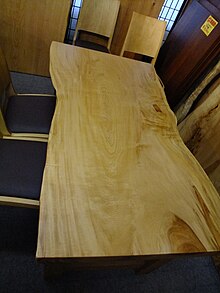Japanese horse chestnut
| Japanese horse chestnut | ||||||||||||
|---|---|---|---|---|---|---|---|---|---|---|---|---|

Japanese horse chestnut ( Aesculus turbinata ) |
||||||||||||
| Systematics | ||||||||||||
|
||||||||||||
| Scientific name | ||||||||||||
| Aesculus turbinata | ||||||||||||
| flower |
The Japanese horse chestnut ( Aesculus turbinata ) is a species of horse chestnut ( Aesculus ). It is native to Japan and is widely planted as an ornamental tree.
description
Vegetative characteristics
The Japanese horse chestnut is a deciduous tree that reaches heights of up to 30 meters and a diameter of up to 2 meters at chest height . The bark of young twigs is hairy.
The constantly against arranged on the branches leaves are divided into petiole and leaf blade. The bald or hairy petiole is 7.5 to 25 inches long. The leaf blade is palmate and consists of five to seven leaflets. The sitting leaflets are lanceolate with a length of 15 to 35 centimeters and a width of 5 to 15 centimeters. They are wide. The underside of the leaf is light to bluish, densely hairy or bald with the exception of domatia . The leaf margin is slightly notched, the leaf base blunt, the leaf end suddenly pointed. There are 18 to 26 pairs of lateral nerves.
Generative characteristics
The inflorescence is a 15 to 25 cm long thyrsus . The inflorescence stem is 2 to 4 centimeters long, the inflorescence itself is conical to cylindrical-conical, 12 to 25, rarely up to 45 centimeters long, at the base 6 to 11 centimeters wide. The side branches are up to 5 centimeters long and each contain five to ten flowers. The flower stalks are 3 to 4 mm long.
The calyx is 3 to 5 mm long, bell-shaped and downy on the outside, ciliate on the edge. The four, rarely five petals are 7 to 10, rarely 12 mm long and densely hairy. They are white or light yellow with red spots, the nail is yellow, later red. The six to seven stamens are 10 to 18 mm long. The stamens are shaggy, the anthers are downy hairy. The pistil is shaggy with hair. Flowering time is May to July.
The capsule fruit is up to 5 centimeters wide and obovate to ovoid and has a warty surface. The pericarp is 3 to 6 mm thick when dry. The capsule fruit usually contains a brown seed with a diameter of about 3 centimeters. The navel increases from the proximal side seen one half of the seed surface. Fruit ripens in September.
The number of chromosomes is 2n = 40.
Occurrence
The Japanese chestnut is only found in Japan and is native to Hokkaidō , the central and northern part of Honshū, and Shikoku . It grows here in moist forests at altitudes from 0 to 2000 meters.
Systematics
The Japanese chestnut ( Aesculus turbinata ) is quite similar to the European common horse chestnut ( Aesculus hippocastanum ) and together with it forms the section Aesculus .
use
The Japanese chestnut is cultivated as an ornamental plant in Europe, the USA and China. In China as well as in England it was confused at times with Aesculus chinensis , which among other things led to Aesculus turbinata being considered native to China.
supporting documents
- James W. Hardin: Studies in the Hippocastanaceae V. Species of the Old World. In: Brittonia , Volume 12, 1960, pp. 26-38.
- Nianhe Xia, Nicholas J. Turland: Aesculus . In: Flora of China , Volume 12, 2007, pp. 2-4. (pdf; 197 kB)





